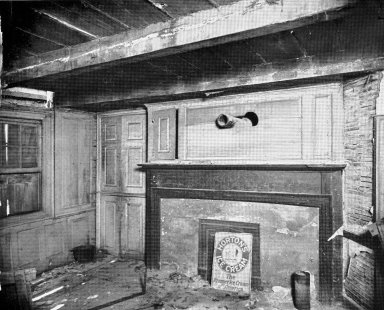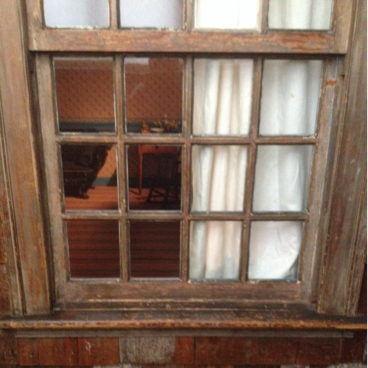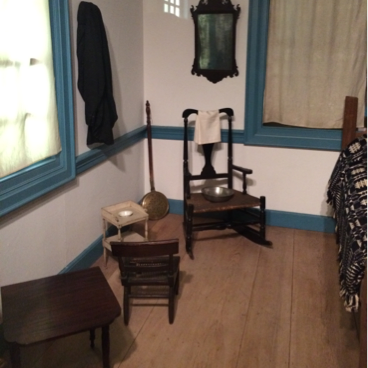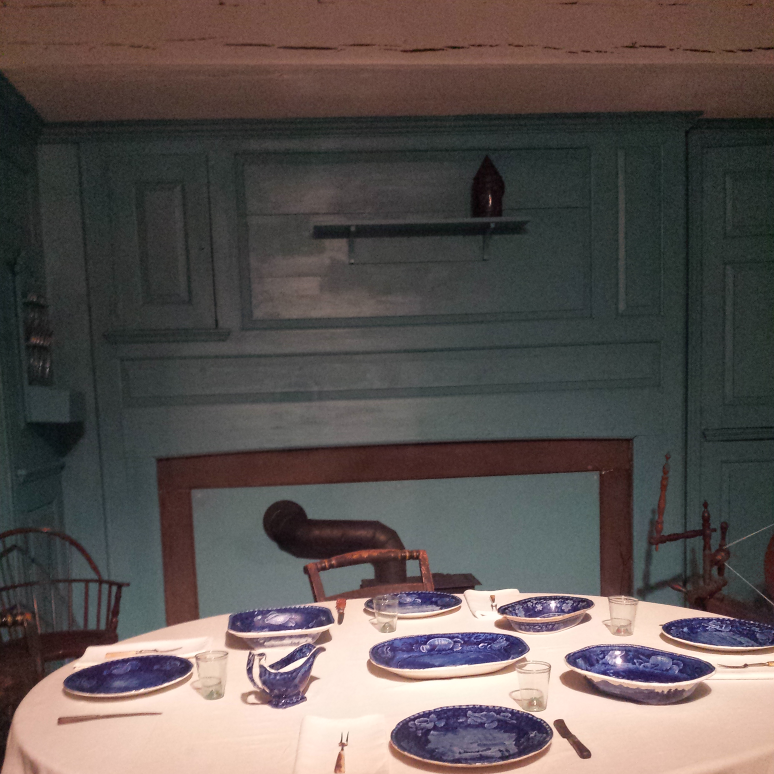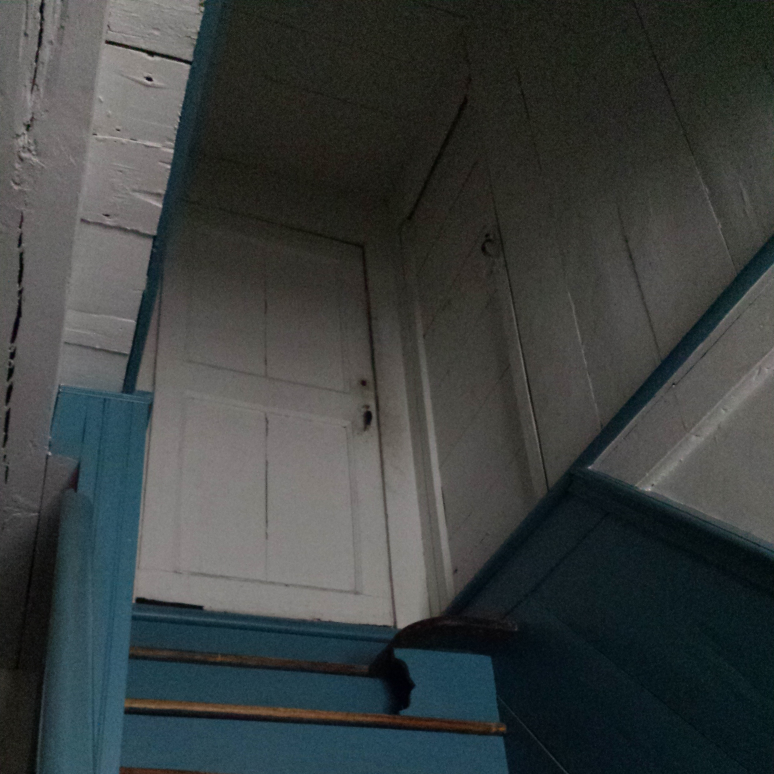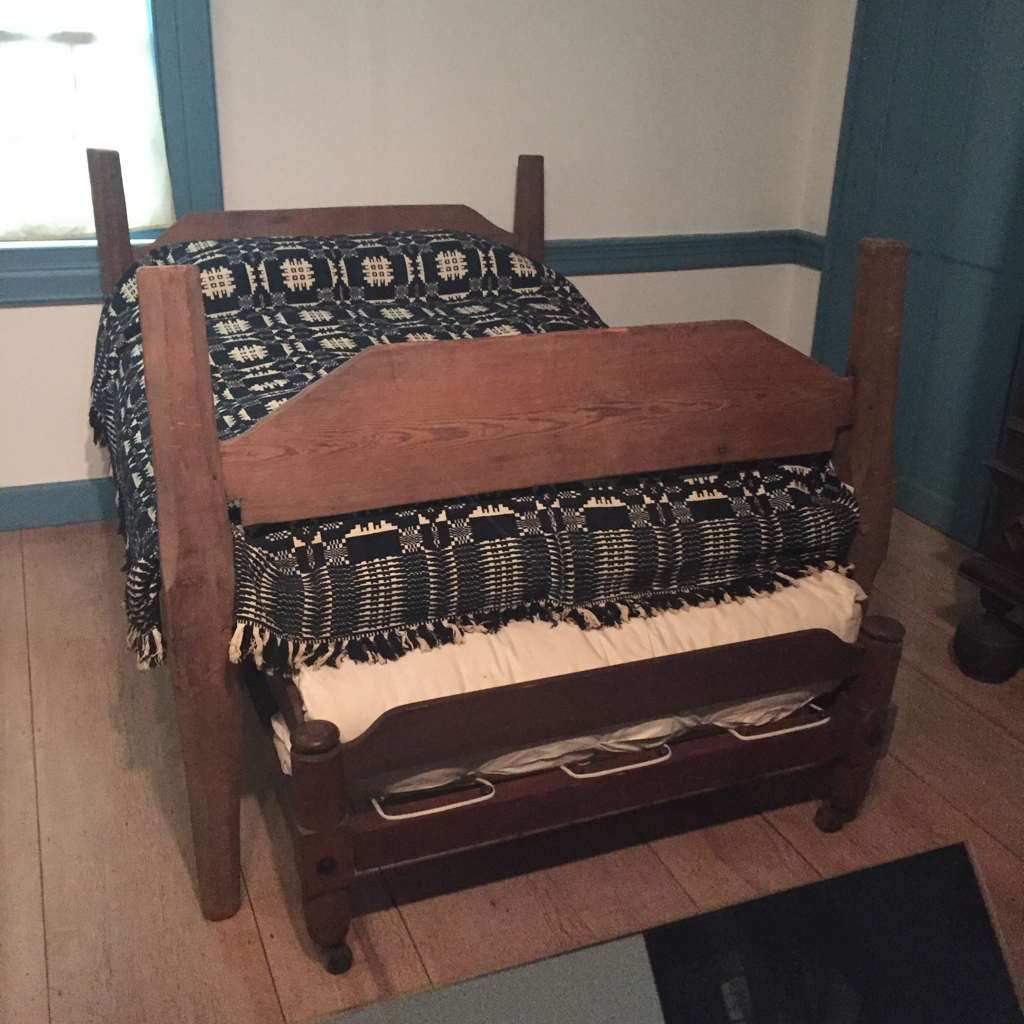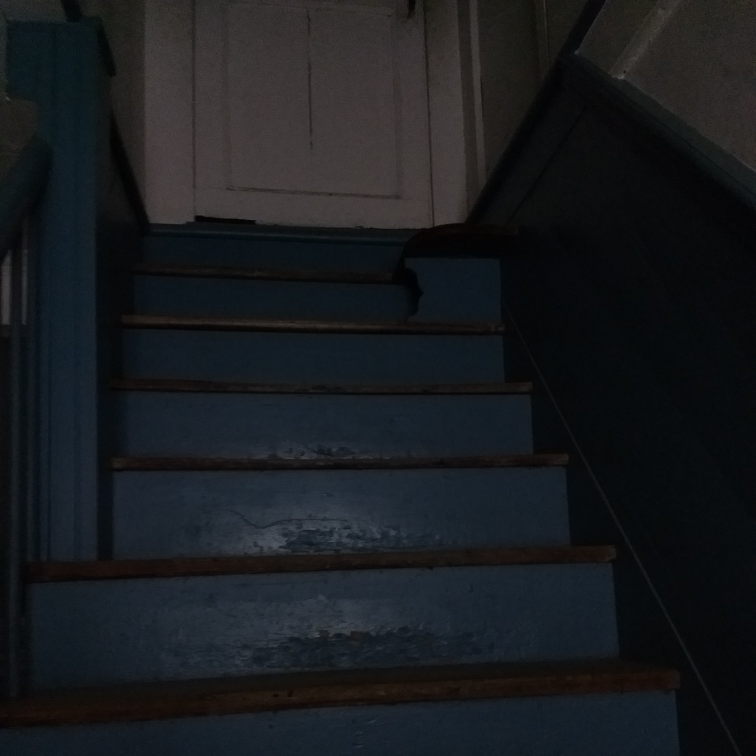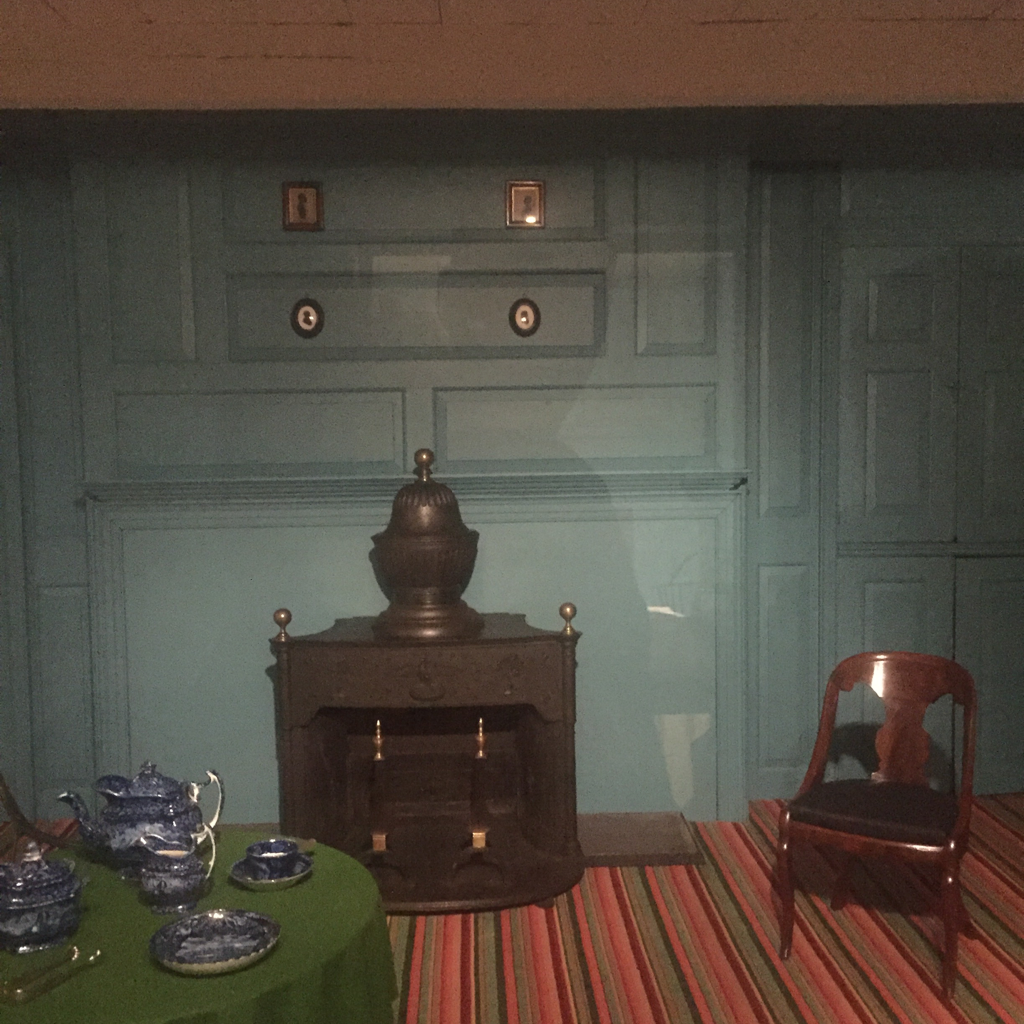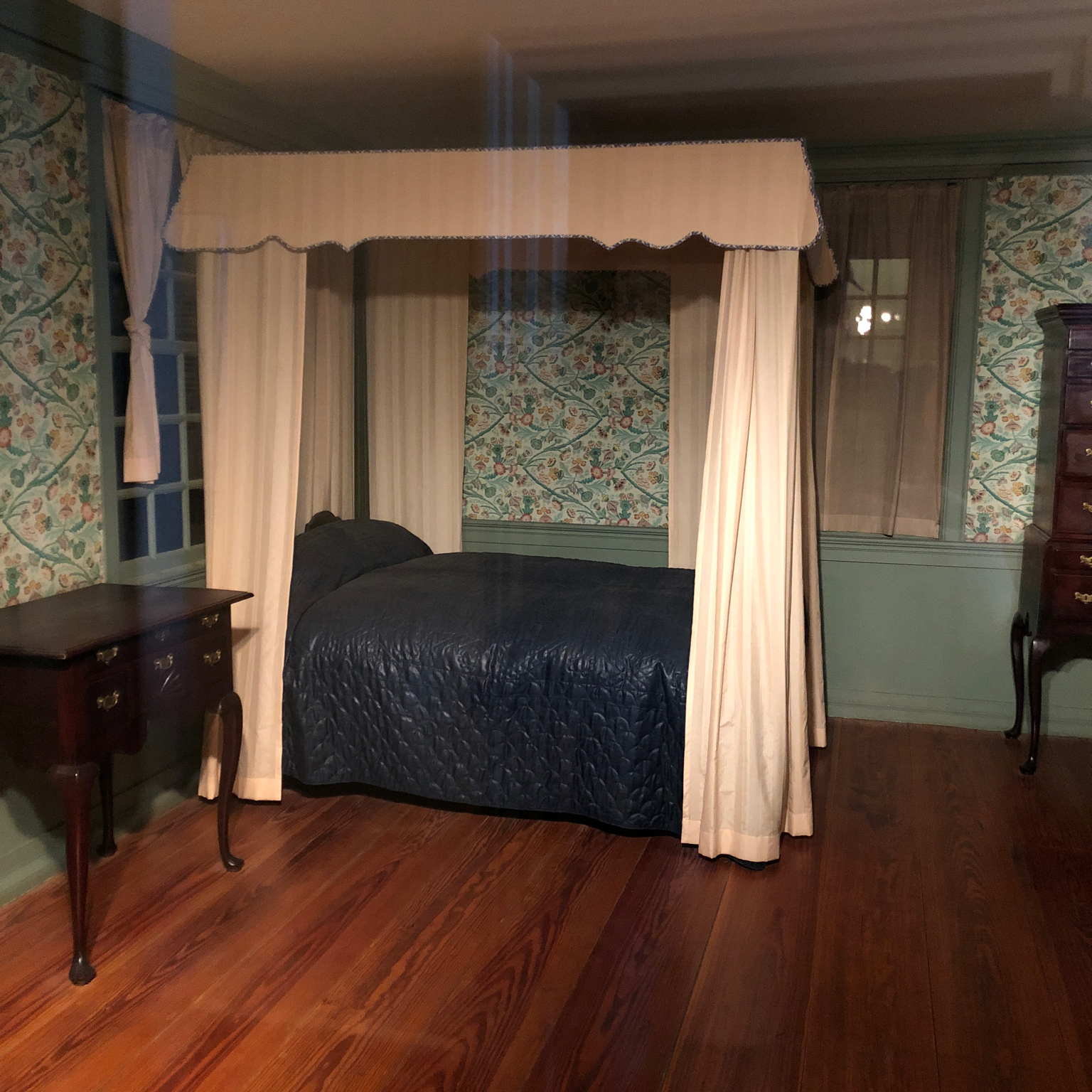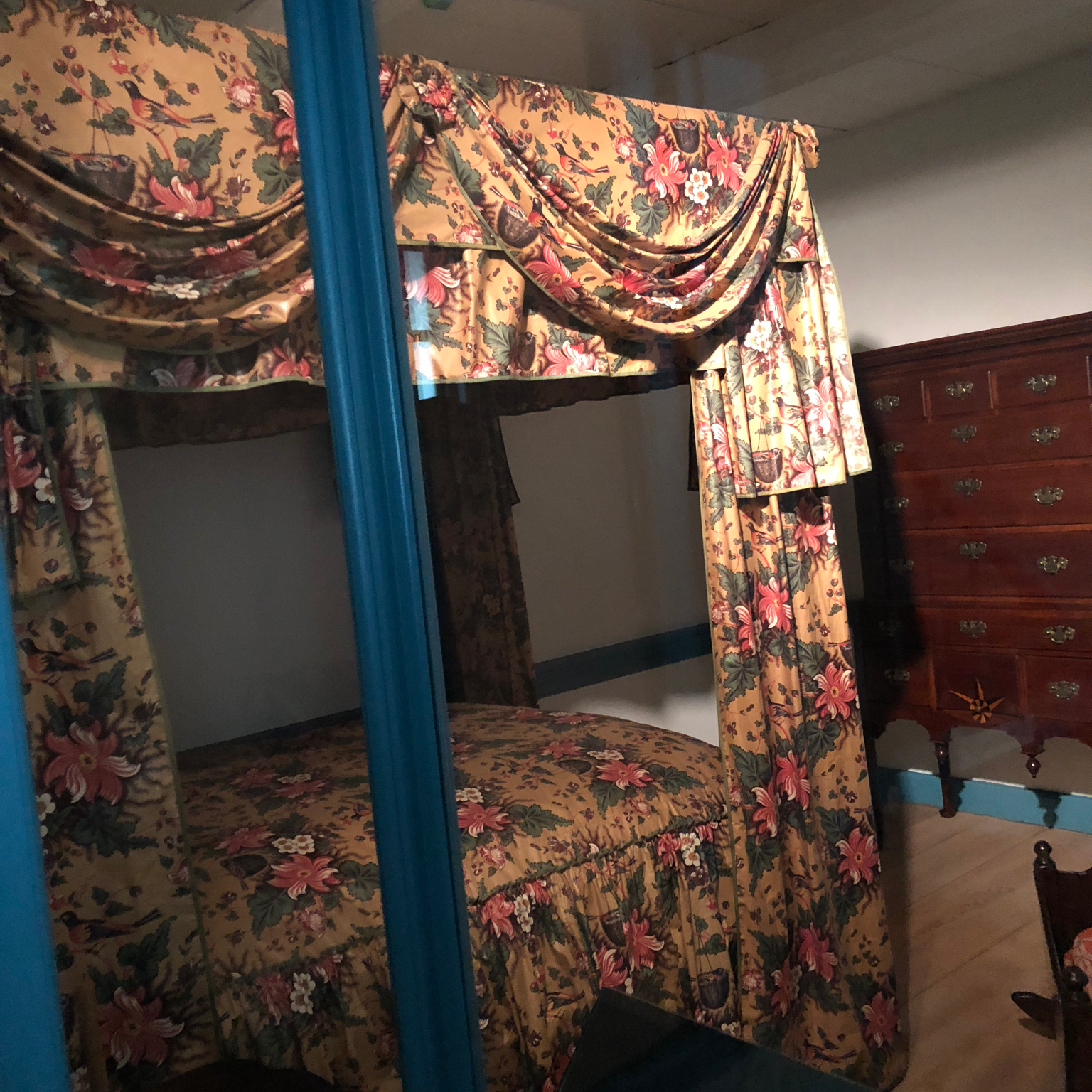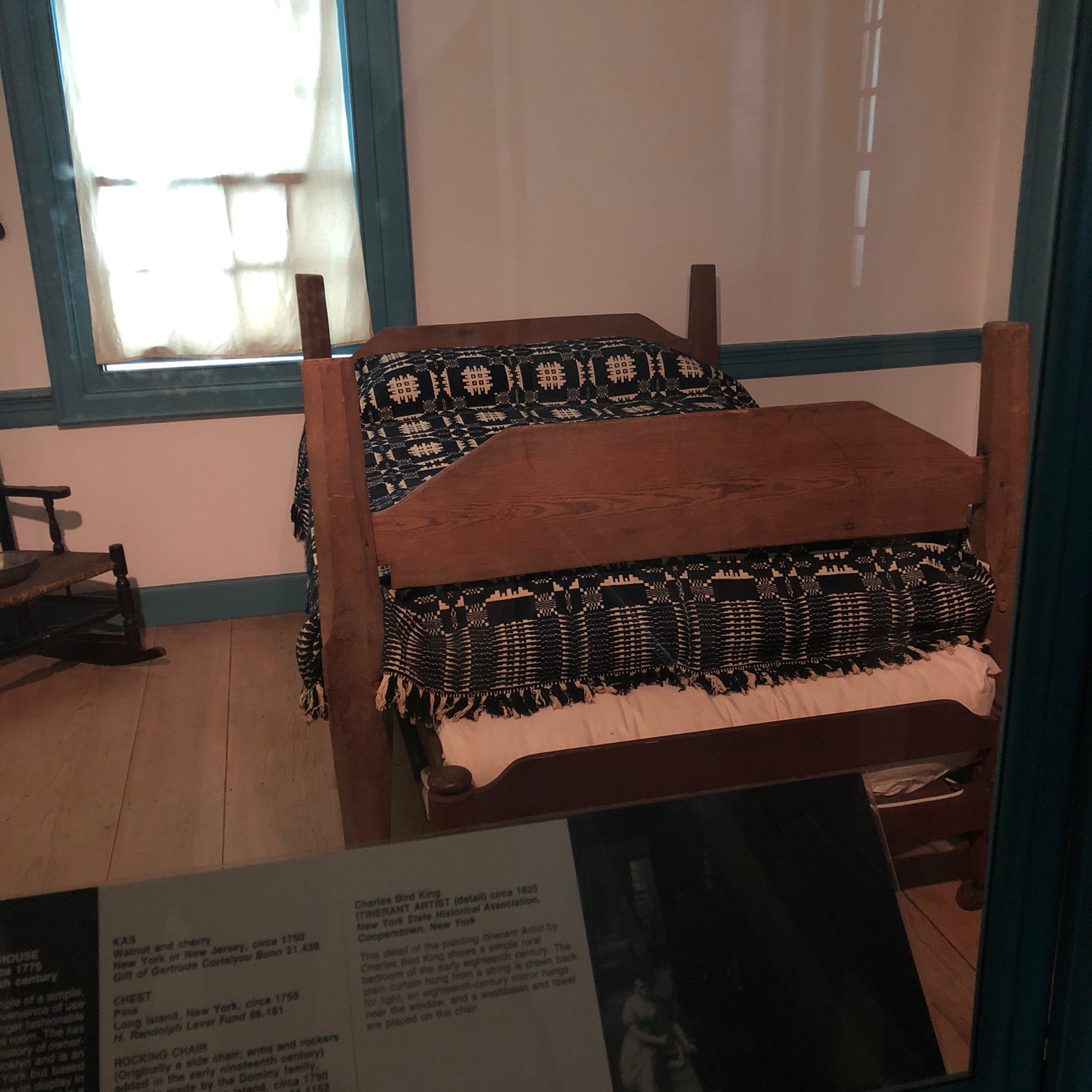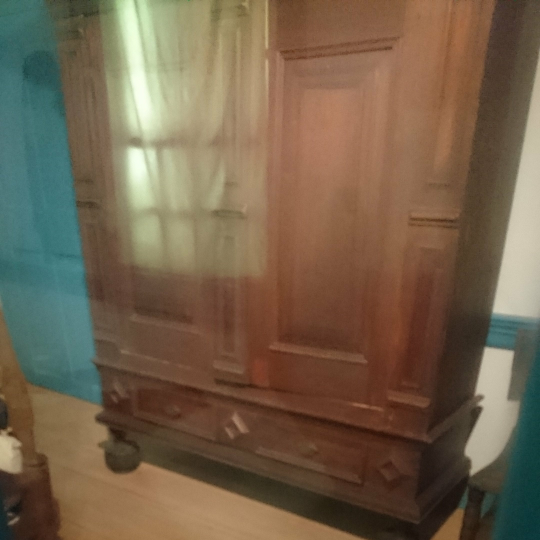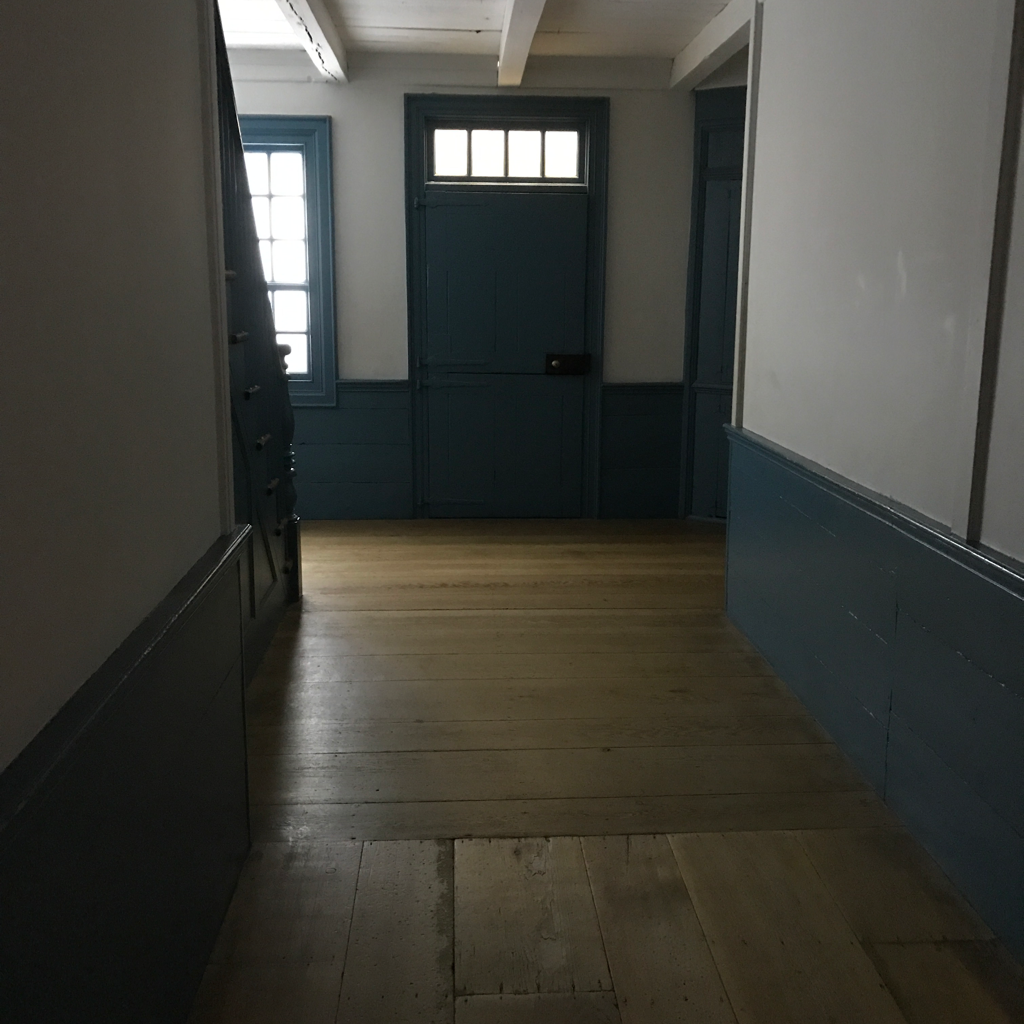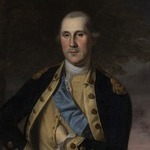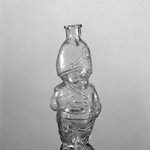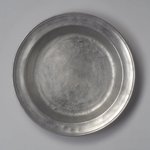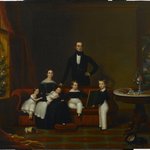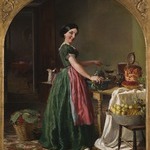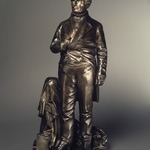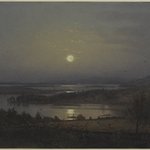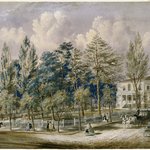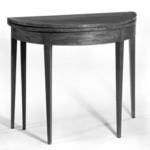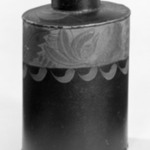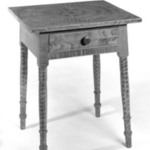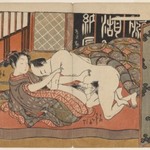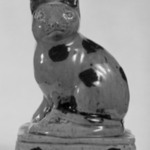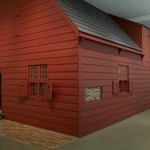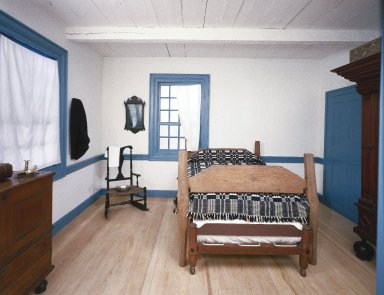

Nicholas Schenck. Nicholas Schenck House from Canarsie Park, ca. 1770–1775. Whole house Brooklyn Museum, Gift of the City of New York Parks and Recreation, 29.1283. Creative Commons-BY (Photo: Brooklyn Museum, 29.1283_transp00954c005_yr1984_installation_northeast_bedroom_IMLS_SL2.jpg)

Nicholas Schenck. Nicholas Schenck House from Canarsie Park, ca. 1770–1775. Whole house Brooklyn Museum, Gift of the City of New York Parks and Recreation, 29.1283. Creative Commons-BY (Photo: Brooklyn Museum, 29.1283_transp03633c001_yr1984_installation_dining_room_IMLS_SL2.jpg)
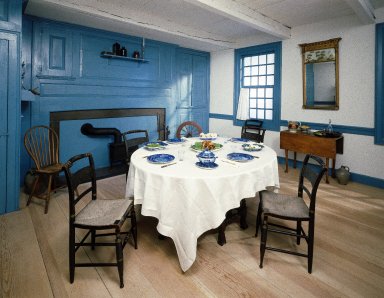
Nicholas Schenck. Nicholas Schenck House from Canarsie Park, ca. 1770–1775. Whole house Brooklyn Museum, Gift of the City of New York Parks and Recreation, 29.1283. Creative Commons-BY (Photo: Brooklyn Museum, 29.1283_transp03633c004_yr1984_installation_dining_room_IMLS_SL2.jpg)

Nicholas Schenck. Nicholas Schenck House from Canarsie Park, ca. 1770–1775. Whole house Brooklyn Museum, Gift of the City of New York Parks and Recreation, 29.1283. Creative Commons-BY (Photo: Brooklyn Museum, 29.1283_yr1984_installation_hall_IMLS_SL2.jpg)
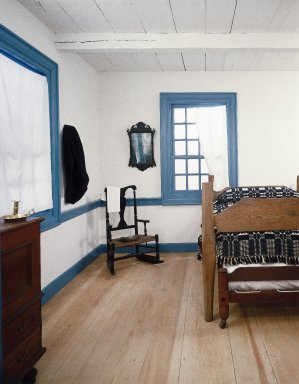
Nicholas Schenck. Nicholas Schenck House from Canarsie Park, ca. 1770–1775. Whole house Brooklyn Museum, Gift of the City of New York Parks and Recreation, 29.1283. Creative Commons-BY (Photo: Brooklyn Museum, 29.1283_yr1984_installation_northeast_bedroom_view1_IMLS_SL2.jpg)
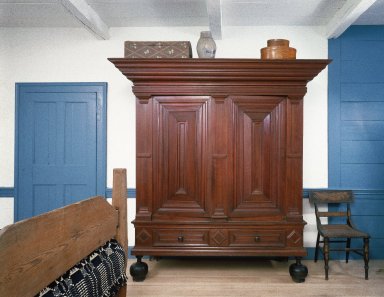
Nicholas Schenck. Nicholas Schenck House from Canarsie Park, ca. 1770–1775. Whole house Brooklyn Museum, Gift of the City of New York Parks and Recreation, 29.1283. Creative Commons-BY (Photo: Brooklyn Museum, 29.1283_yr1984_installation_northeast_bedroom_view2_IMLS_SL2.jpg)
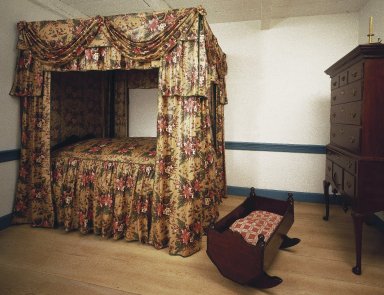
Nicholas Schenck. Nicholas Schenck House from Canarsie Park, ca. 1770–1775. Whole house Brooklyn Museum, Gift of the City of New York Parks and Recreation, 29.1283. Creative Commons-BY (Photo: Brooklyn Museum, 29.1283_yr1984_installation_northwest_bedroom_view1_IMLS_SL2.jpg)

Nicholas Schenck. Nicholas Schenck House from Canarsie Park, ca. 1770–1775. Whole house Brooklyn Museum, Gift of the City of New York Parks and Recreation, 29.1283. Creative Commons-BY (Photo: Brooklyn Museum, 29.1283_yr1984_installation_northwest_bedroom_view2_IMLS_SL2.jpg)
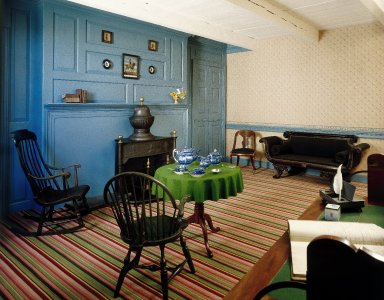
Nicholas Schenck. Nicholas Schenck House from Canarsie Park, ca. 1770–1775. Whole house Brooklyn Museum, Gift of the City of New York Parks and Recreation, 29.1283. Creative Commons-BY (Photo: Brooklyn Museum, 29.1283_yr1984_installation_parlor_IMLS_SL2.jpg)
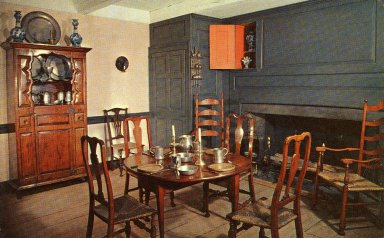
Nicholas Schenck. Nicholas Schenck House from Canarsie Park, ca. 1770–1775. Whole house Brooklyn Museum, Gift of the City of New York Parks and Recreation, 29.1283. Creative Commons-BY (Photo: Brooklyn Museum, 29.1283_yr1960_installation_interior_print_IMLS.jpg)

Nicholas Schenck. Nicholas Schenck House from Canarsie Park, ca. 1770–1775. Whole house Brooklyn Museum, Gift of the City of New York Parks and Recreation, 29.1283. Creative Commons-BY (Photo: Brooklyn Museum, 29.1283_view2_print_bw_SL1.jpg)
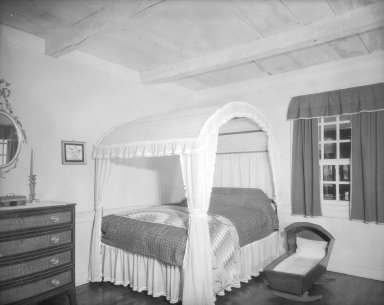
Nicholas Schenck. Nicholas Schenck House from Canarsie Park, ca. 1770–1775. Whole house Brooklyn Museum, Gift of the City of New York Parks and Recreation, 29.1283. Creative Commons-BY (Photo: Brooklyn Museum, 29.1283_bedroom_bw.jpg)
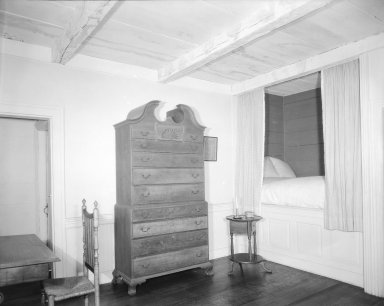
Nicholas Schenck. Nicholas Schenck House from Canarsie Park, ca. 1770–1775. Whole house Brooklyn Museum, Gift of the City of New York Parks and Recreation, 29.1283. Creative Commons-BY (Photo: Brooklyn Museum, 29.1283_bedroom_nook_bw.jpg)
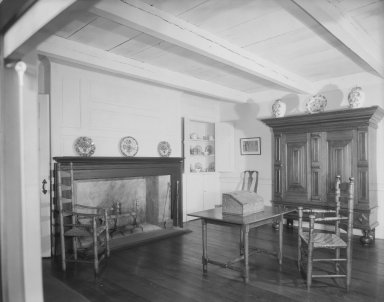
Nicholas Schenck. Nicholas Schenck House from Canarsie Park, ca. 1770–1775. Whole house Brooklyn Museum, Gift of the City of New York Parks and Recreation, 29.1283. Creative Commons-BY (Photo: Brooklyn Museum, 29.1283_living_room_bw.jpg)
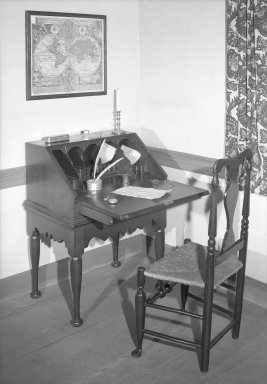
Nicholas Schenck. Nicholas Schenck House from Canarsie Park, ca. 1770–1775. Whole house Brooklyn Museum, Gift of the City of New York Parks and Recreation, 29.1283. Creative Commons-BY (Photo: Brooklyn Museum, 29.1283_yr1968_installation_back_bedroom3_bw_IMLS.jpg)
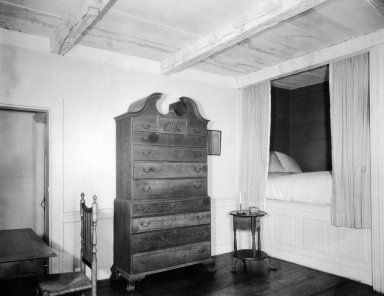
Nicholas Schenck. Nicholas Schenck House from Canarsie Park, ca. 1770–1775. Whole house Brooklyn Museum, Gift of the City of New York Parks and Recreation, 29.1283. Creative Commons-BY (Photo: Brooklyn Museum, 29.1283_installation_bedroom_nook1_print_bw_IMLS.jpg)

Nicholas Schenck. Nicholas Schenck House from Canarsie Park, ca. 1770–1775. Whole house Brooklyn Museum, Gift of the City of New York Parks and Recreation, 29.1283. Creative Commons-BY (Photo: Brooklyn Museum, 29.1283_installation_bedroom_nook2b_print_bw_IMLS.jpg)

Nicholas Schenck. Nicholas Schenck House from Canarsie Park, ca. 1770–1775. Whole house Brooklyn Museum, Gift of the City of New York Parks and Recreation, 29.1283. Creative Commons-BY (Photo: Brooklyn Museum, 29.1283_installation_bedroom1_print_bw_IMLS.jpg)
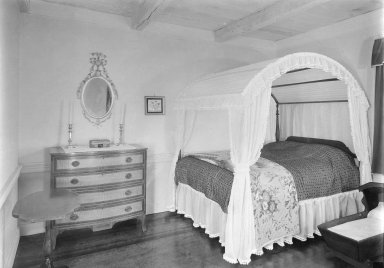
Nicholas Schenck. Nicholas Schenck House from Canarsie Park, ca. 1770–1775. Whole house Brooklyn Museum, Gift of the City of New York Parks and Recreation, 29.1283. Creative Commons-BY (Photo: Brooklyn Museum, 29.1283_installation_bedroom2_print_bw_IMLS.jpg)

Nicholas Schenck. Nicholas Schenck House from Canarsie Park, ca. 1770–1775. Whole house Brooklyn Museum, Gift of the City of New York Parks and Recreation, 29.1283. Creative Commons-BY (Photo: Brooklyn Museum, 29.1283_installation_bedroom3_print_bw_IMLS.jpg)

Nicholas Schenck. Nicholas Schenck House from Canarsie Park, ca. 1770–1775. Whole house Brooklyn Museum, Gift of the City of New York Parks and Recreation, 29.1283. Creative Commons-BY (Photo: Brooklyn Museum, 29.1283_installation_living_room1_print_bw_IMLS.jpg)
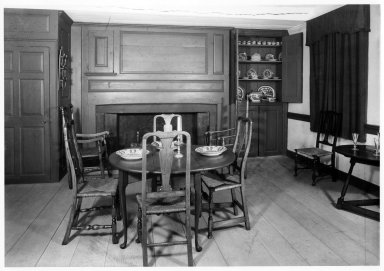
Nicholas Schenck. Nicholas Schenck House from Canarsie Park, ca. 1770–1775. Whole house Brooklyn Museum, Gift of the City of New York Parks and Recreation, 29.1283. Creative Commons-BY (Photo: Brooklyn Museum, 29.1283_installation_living_room2_print_bw_IMLS.jpg)

Nicholas Schenck. Nicholas Schenck House from Canarsie Park, ca. 1770–1775. Whole house Brooklyn Museum, Gift of the City of New York Parks and Recreation, 29.1283. Creative Commons-BY (Photo: Brooklyn Museum, 29.1283_installation_living_room3_print_bw_IMLS.jpg)
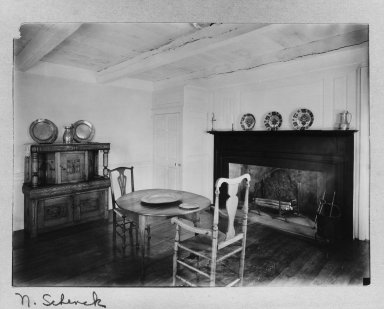
Nicholas Schenck. Nicholas Schenck House from Canarsie Park, ca. 1770–1775. Whole house Brooklyn Museum, Gift of the City of New York Parks and Recreation, 29.1283. Creative Commons-BY (Photo: Brooklyn Museum, 29.1283_installation_living_room4_print_bw_IMLS.jpg)
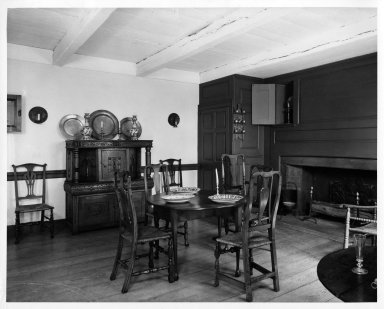
Nicholas Schenck. Nicholas Schenck House from Canarsie Park, ca. 1770–1775. Whole house Brooklyn Museum, Gift of the City of New York Parks and Recreation, 29.1283. Creative Commons-BY (Photo: Brooklyn Museum, 29.1283_installation_living_room5_print_bw_IMLS.jpg)
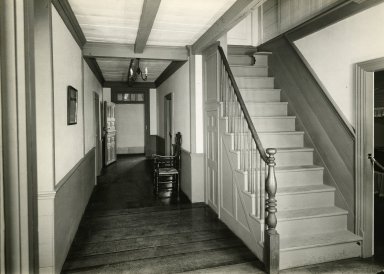
Nicholas Schenck. Nicholas Schenck House from Canarsie Park, ca. 1770–1775. Whole house Brooklyn Museum, Gift of the City of New York Parks and Recreation, 29.1283. Creative Commons-BY (Photo: Brooklyn Museum, 29.1283_installation_stairhall2_print_bw_IMLS.jpg)
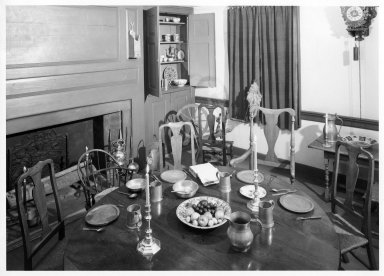
Nicholas Schenck. Nicholas Schenck House from Canarsie Park, ca. 1770–1775. Whole house Brooklyn Museum, Gift of the City of New York Parks and Recreation, 29.1283. Creative Commons-BY (Photo: Brooklyn Museum, 29.1283_yr1968_installation_dining_room_IMLS.jpg)
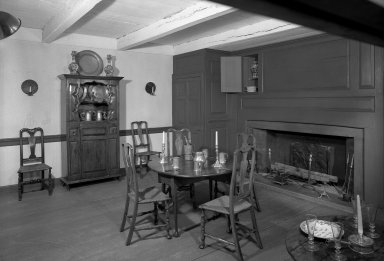
Nicholas Schenck. Nicholas Schenck House from Canarsie Park, ca. 1770–1775. Whole house Brooklyn Museum, Gift of the City of New York Parks and Recreation, 29.1283. Creative Commons-BY (Photo: , 29.1283_29.1592.1_dining_room_view1_acetate_bw.jpg)
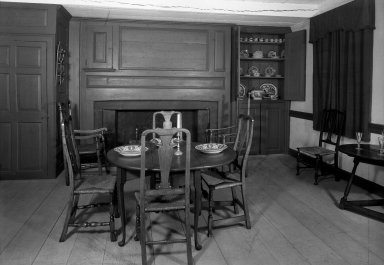
Nicholas Schenck. Nicholas Schenck House from Canarsie Park, ca. 1770–1775. Whole house Brooklyn Museum, Gift of the City of New York Parks and Recreation, 29.1283. Creative Commons-BY (Photo: , 29.1283_29.1592.1_dining_room_view3_acetate_bw.jpg)
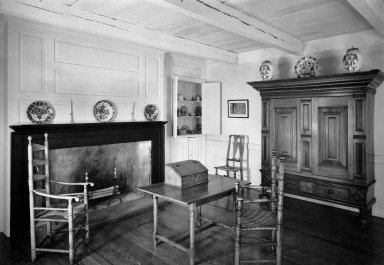
Nicholas Schenck. Nicholas Schenck House from Canarsie Park, ca. 1770–1775. Whole house Brooklyn Museum, Gift of the City of New York Parks and Recreation, 29.1283. Creative Commons-BY (Photo: Brooklyn Museum, 29.1283_neg1424_yr1938_installation_fireplace_bw_IMLS.jpg)

Nicholas Schenck. Nicholas Schenck House from Canarsie Park, ca. 1770–1775. Whole house Brooklyn Museum, Gift of the City of New York Parks and Recreation, 29.1283. Creative Commons-BY (Photo: Brooklyn Museum, 29.1283_neg22834_yr1968_installation_back_bedroom_bw_IMLS.jpg)

Nicholas Schenck. Nicholas Schenck House from Canarsie Park, ca. 1770–1775. Whole house Brooklyn Museum, Gift of the City of New York Parks and Recreation, 29.1283. Creative Commons-BY (Photo: Brooklyn Museum, 29.1283_yr1929_installation_dining_room_bw_IMLS.jpg)
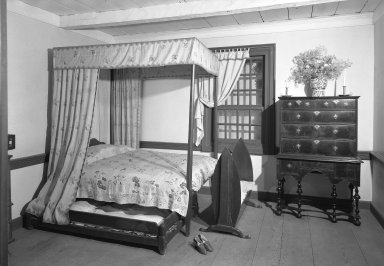
Nicholas Schenck. Nicholas Schenck House from Canarsie Park, ca. 1770–1775. Whole house Brooklyn Museum, Gift of the City of New York Parks and Recreation, 29.1283. Creative Commons-BY (Photo: Brooklyn Museum, 29.1283_yr1968_installation_back_bedroom1_bw_IMLS.jpg)
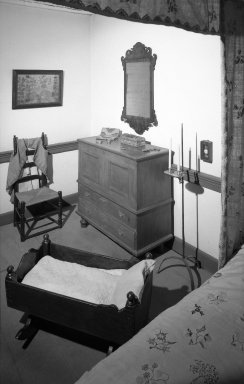
Nicholas Schenck. Nicholas Schenck House from Canarsie Park, ca. 1770–1775. Whole house Brooklyn Museum, Gift of the City of New York Parks and Recreation, 29.1283. Creative Commons-BY (Photo: Brooklyn Museum, 29.1283_yr1968_installation_back_bedroom2_bw_IMLS.jpg)
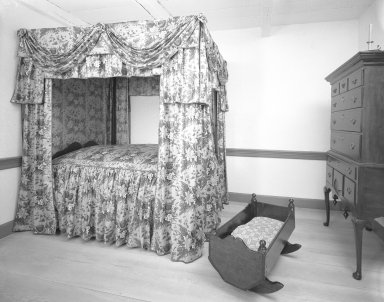
Nicholas Schenck. Nicholas Schenck House from Canarsie Park, ca. 1770–1775. Whole house Brooklyn Museum, Gift of the City of New York Parks and Recreation, 29.1283. Creative Commons-BY (Photo: Paul Warchol, 29.1283_yr1984_installation_back_bedroom1_bw_IMLS.jpg)
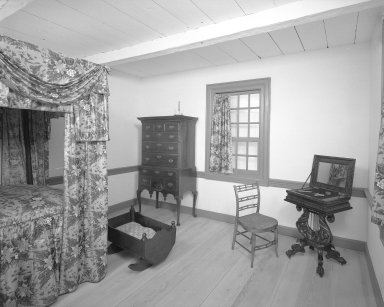
Nicholas Schenck. Nicholas Schenck House from Canarsie Park, ca. 1770–1775. Whole house Brooklyn Museum, Gift of the City of New York Parks and Recreation, 29.1283. Creative Commons-BY (Photo: Paul Warchol, 29.1283_yr1984_installation_back_bedroom2_bw_IMLS.jpg)
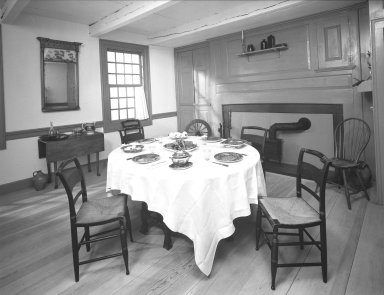
Nicholas Schenck. Nicholas Schenck House from Canarsie Park, ca. 1770–1775. Whole house Brooklyn Museum, Gift of the City of New York Parks and Recreation, 29.1283. Creative Commons-BY (Photo: Paul Warchol, 29.1283_yr1984_installation_dining_room1_bw_IMLS.jpg)
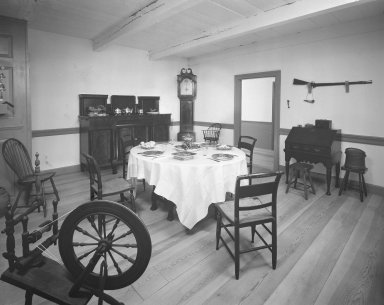
Nicholas Schenck. Nicholas Schenck House from Canarsie Park, ca. 1770–1775. Whole house Brooklyn Museum, Gift of the City of New York Parks and Recreation, 29.1283. Creative Commons-BY (Photo: Paul Warchol, 29.1283_yr1984_installation_dining_room2_bw_IMLS.jpg)
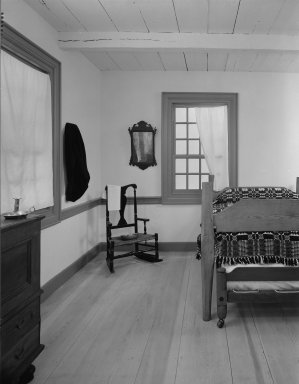
Nicholas Schenck. Nicholas Schenck House from Canarsie Park, ca. 1770–1775. Whole house Brooklyn Museum, Gift of the City of New York Parks and Recreation, 29.1283. Creative Commons-BY (Photo: Paul Warchol, 29.1283_yr1984_installation_front_bedroom1_bw_IMLS.jpg)
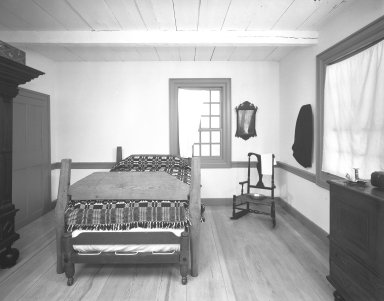
Nicholas Schenck. Nicholas Schenck House from Canarsie Park, ca. 1770–1775. Whole house Brooklyn Museum, Gift of the City of New York Parks and Recreation, 29.1283. Creative Commons-BY (Photo: Paul Warchol, 29.1283_yr1984_installation_front_bedroom2_bw_IMLS.jpg)
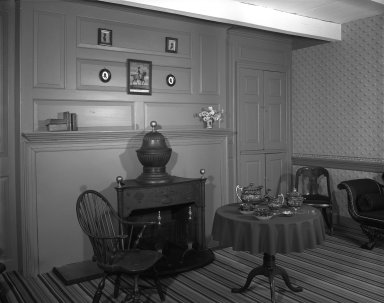
Nicholas Schenck. Nicholas Schenck House from Canarsie Park, ca. 1770–1775. Whole house Brooklyn Museum, Gift of the City of New York Parks and Recreation, 29.1283. Creative Commons-BY (Photo: Brooklyn Museum, 29.1283_yr1984_installation_parlor1_bw_IMLS.jpg)
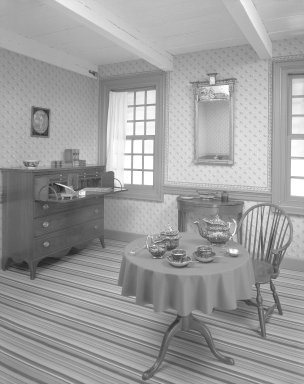
Nicholas Schenck. Nicholas Schenck House from Canarsie Park, ca. 1770–1775. Whole house Brooklyn Museum, Gift of the City of New York Parks and Recreation, 29.1283. Creative Commons-BY (Photo: Paul Warchol, 29.1283_yr1984_installation_parlor2_bw_IMLS.jpg)
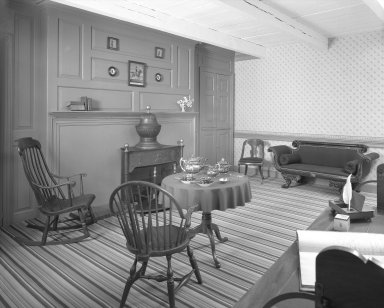
Nicholas Schenck. Nicholas Schenck House from Canarsie Park, ca. 1770–1775. Whole house Brooklyn Museum, Gift of the City of New York Parks and Recreation, 29.1283. Creative Commons-BY (Photo: Paul Warchol, 29.1283_yr1984_installation_parlor3_bw_IMLS.jpg)
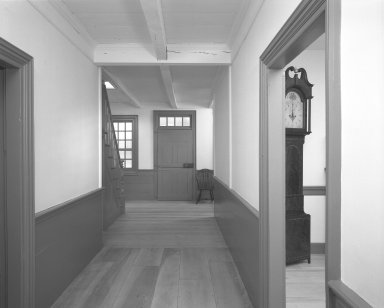
Nicholas Schenck. Nicholas Schenck House from Canarsie Park, ca. 1770–1775. Whole house Brooklyn Museum, Gift of the City of New York Parks and Recreation, 29.1283. Creative Commons-BY (Photo: Paul Warchol, 29.1283_yr1984_installation_stairhall_bw_IMLS.jpg)
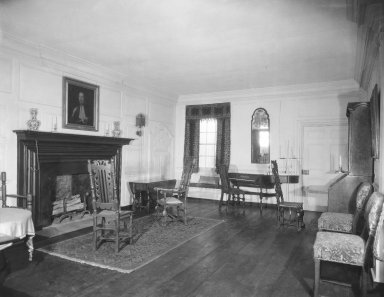
Nicholas Schenck. Nicholas Schenck House from Canarsie Park, ca. 1770–1775. Whole house Brooklyn Museum, Gift of the City of New York Parks and Recreation, 29.1283. Creative Commons-BY (Photo: Brooklyn Museum, 29.1283_living_room_print_bw_SL1.jpg)

Nicholas Schenck. Nicholas Schenck House from Canarsie Park, ca. 1770–1775. Whole house Brooklyn Museum, Gift of the City of New York Parks and Recreation, 29.1283. Creative Commons-BY (Photo: Brooklyn Museum, 29.1283_parlor_print_bw_SL1.jpg)

Nicholas Schenck. Nicholas Schenck House from Canarsie Park, ca. 1770–1775. Whole house Brooklyn Museum, Gift of the City of New York Parks and Recreation, 29.1283. Creative Commons-BY (Photo: Brooklyn Museum, 29.1283_view1_print_bw_SL1.jpg)
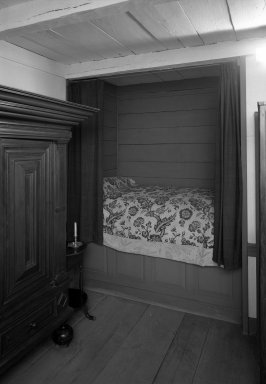
Nicholas Schenck. Nicholas Schenck House from Canarsie Park, ca. 1770–1775. Whole house Brooklyn Museum, Gift of the City of New York Parks and Recreation, 29.1283. Creative Commons-BY (Photo: Brooklyn Museum, 29.1283_alcove_bed_acetate_bw.jpg)
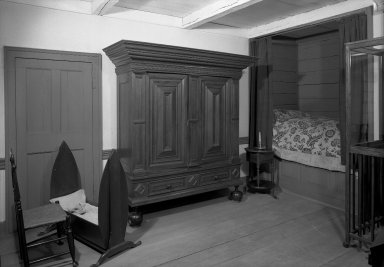
Nicholas Schenck. Nicholas Schenck House from Canarsie Park, ca. 1770–1775. Whole house Brooklyn Museum, Gift of the City of New York Parks and Recreation, 29.1283. Creative Commons-BY (Photo: Brooklyn Museum, 29.1283_bedroom_acetate_bw.jpg)

Nicholas Schenck. Nicholas Schenck House from Canarsie Park, ca. 1770–1775. Whole house Brooklyn Museum, Gift of the City of New York Parks and Recreation, 29.1283. Creative Commons-BY (Photo: Brooklyn Museum, 29.1283_back_bedroom_acetate_bw.jpg)

Nicholas Schenck. Nicholas Schenck House from Canarsie Park, ca. 1770–1775. Whole house Brooklyn Museum, Gift of the City of New York Parks and Recreation, 29.1283. Creative Commons-BY (Photo: Brooklyn Museum, 29.1283_bedroom_trundle_acetate_bw.jpg)
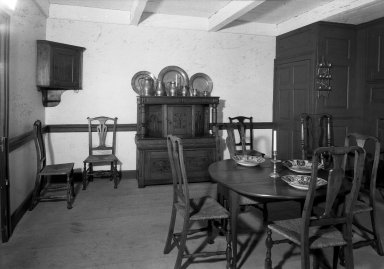
Nicholas Schenck. Nicholas Schenck House from Canarsie Park, ca. 1770–1775. Whole house Brooklyn Museum, Gift of the City of New York Parks and Recreation, 29.1283. Creative Commons-BY (Photo: Brooklyn Museum, 29.1283_dining_room_view2_acetate_bw.jpg)

Nicholas Schenck. Nicholas Schenck House from Canarsie Park, ca. 1770–1775. Whole house Brooklyn Museum, Gift of the City of New York Parks and Recreation, 29.1283. Creative Commons-BY (Photo: Brooklyn Museum, 29.1283_living_room_view1_acetate_bw.jpg)
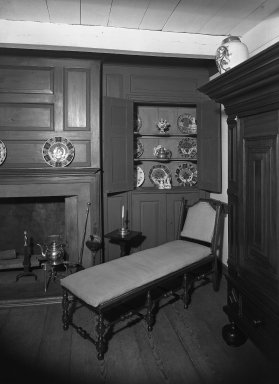
Nicholas Schenck. Nicholas Schenck House from Canarsie Park, ca. 1770–1775. Whole house Brooklyn Museum, Gift of the City of New York Parks and Recreation, 29.1283. Creative Commons-BY (Photo: Brooklyn Museum, 29.1283_living_room_view2_acetate_bw.jpg)
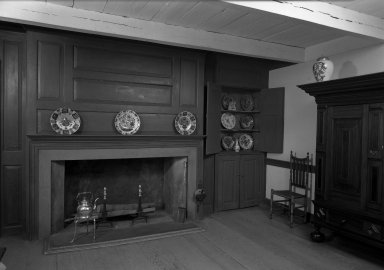
Nicholas Schenck. Nicholas Schenck House from Canarsie Park, ca. 1770–1775. Whole house Brooklyn Museum, Gift of the City of New York Parks and Recreation, 29.1283. Creative Commons-BY (Photo: Brooklyn Museum, 29.1283_parlor_view1_acetate_bw.jpg)
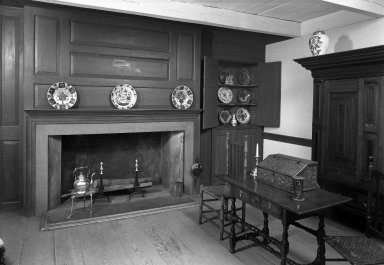
Nicholas Schenck. Nicholas Schenck House from Canarsie Park, ca. 1770–1775. Whole house Brooklyn Museum, Gift of the City of New York Parks and Recreation, 29.1283. Creative Commons-BY (Photo: Brooklyn Museum, 29.1283_parlor_view2_acetate_bw.jpg)
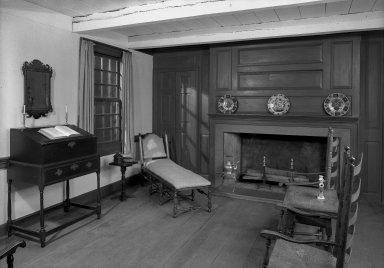
Nicholas Schenck. Nicholas Schenck House from Canarsie Park, ca. 1770–1775. Whole house Brooklyn Museum, Gift of the City of New York Parks and Recreation, 29.1283. Creative Commons-BY (Photo: Brooklyn Museum, 29.1283_parlor_view3_acetate_bw.jpg)
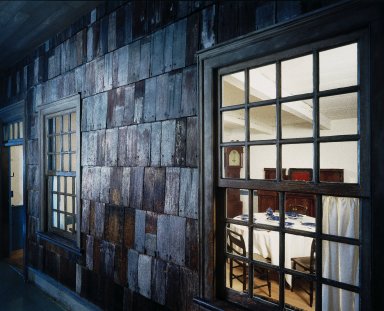
Nicholas Schenck. Nicholas Schenck House from Canarsie Park, ca. 1770–1775. Whole house Brooklyn Museum, Gift of the City of New York Parks and Recreation, 29.1283. Creative Commons-BY (Photo: Brooklyn Museum, 29.1283_yr1984_installation_exterior_IMLS_SL2.jpg)
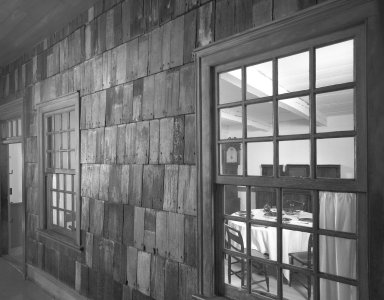
Nicholas Schenck. Nicholas Schenck House from Canarsie Park, ca. 1770–1775. Whole house Brooklyn Museum, Gift of the City of New York Parks and Recreation, 29.1283. Creative Commons-BY (Photo: Paul Warchol, 29.1283_yr1987_installation_exterior_bw_IMLS.jpg)
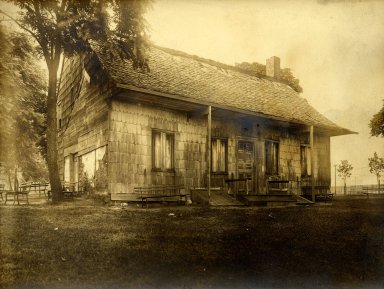
Nicholas Schenck. Nicholas Schenck House from Canarsie Park, ca. 1770–1775. Whole house Brooklyn Museum, Gift of the City of New York Parks and Recreation, 29.1283. Creative Commons-BY (Photo: Brooklyn Museum, 29.1283_in_situ_exterior3_print_bw_IMLS.jpg)
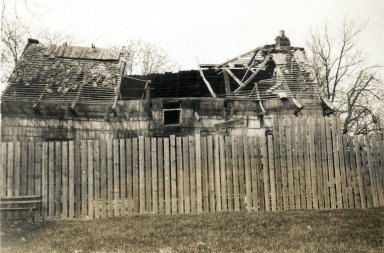
Nicholas Schenck. Nicholas Schenck House from Canarsie Park, ca. 1770–1775. Whole house Brooklyn Museum, Gift of the City of New York Parks and Recreation, 29.1283. Creative Commons-BY (Photo: Brooklyn Museum, 29.1283_neg26_in_situ_exterior_after_damage1_print_bw_IMLS.jpg)
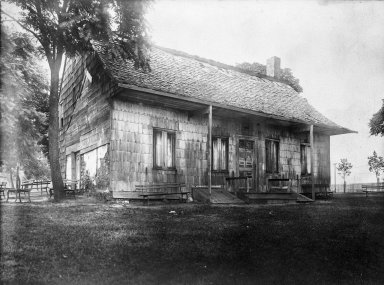
Nicholas Schenck. Nicholas Schenck House from Canarsie Park, ca. 1770–1775. Whole house Brooklyn Museum, Gift of the City of New York Parks and Recreation, 29.1283. Creative Commons-BY (Photo: Brooklyn Museum, 29.1283_in_situ_exterior_overview_preservation_record_negative_bw_IMLS.jpg)
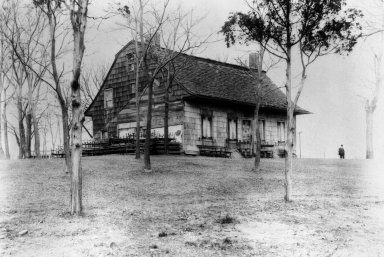
Nicholas Schenck. Nicholas Schenck House from Canarsie Park, ca. 1770–1775. Whole house Brooklyn Museum, Gift of the City of New York Parks and Recreation, 29.1283. Creative Commons-BY (Photo: Brooklyn Museum, 29.1283_in_situ_exterior_preservation_record_negative_bw_IMLS.jpg)
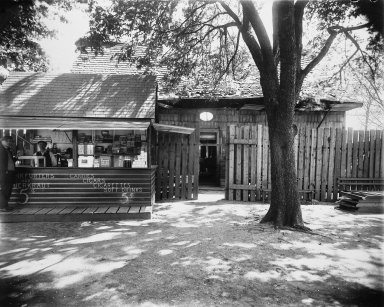
Nicholas Schenck. Nicholas Schenck House from Canarsie Park, ca. 1770–1775. Whole house Brooklyn Museum, Gift of the City of New York Parks and Recreation, 29.1283. Creative Commons-BY (Photo: Brooklyn Museum, 29.1283_neg17513_exterior_north_in_situ_preservation_record_negative_bw_IMLS.jpg)
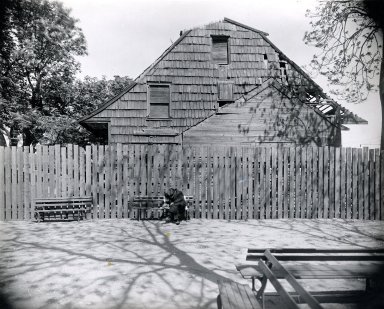
Nicholas Schenck. Nicholas Schenck House from Canarsie Park, ca. 1770–1775. Whole house Brooklyn Museum, Gift of the City of New York Parks and Recreation, 29.1283. Creative Commons-BY (Photo: Brooklyn Museum, 29.1283_in_situ_exterior_after_damage_west_print_bw_IMLS.jpg)
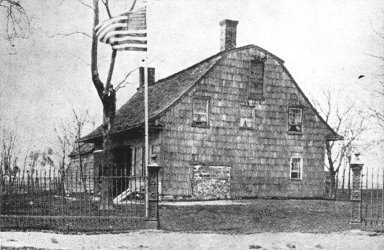
Nicholas Schenck. Nicholas Schenck House from Canarsie Park, ca. 1770–1775. Whole house Brooklyn Museum, Gift of the City of New York Parks and Recreation, 29.1283. Creative Commons-BY (Photo: Brooklyn Museum, 29.1283_in_situ_exterior2_print_bw_IMLS.jpg)

Nicholas Schenck. Nicholas Schenck House from Canarsie Park, ca. 1770–1775. Whole house Brooklyn Museum, Gift of the City of New York Parks and Recreation, 29.1283. Creative Commons-BY (Photo: Brooklyn Museum, 29.1283_in_situ_exterior4_print_bw_IMLS.jpg)
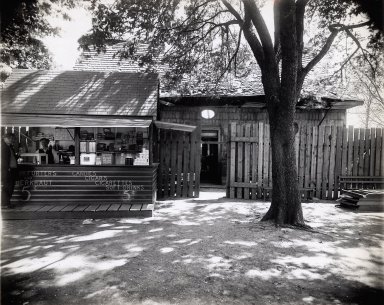
Nicholas Schenck. Nicholas Schenck House from Canarsie Park, ca. 1770–1775. Whole house Brooklyn Museum, Gift of the City of New York Parks and Recreation, 29.1283. Creative Commons-BY (Photo: Brooklyn Museum, 29.1283_neg17513_yr1928_in_situ_exterior_north_print_bw_IMLS.jpg)
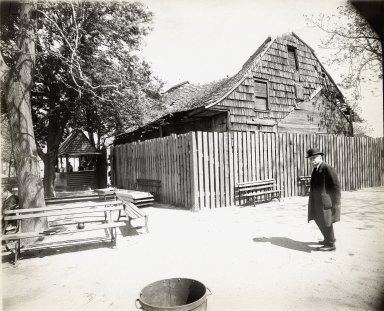
Nicholas Schenck. Nicholas Schenck House from Canarsie Park, ca. 1770–1775. Whole house Brooklyn Museum, Gift of the City of New York Parks and Recreation, 29.1283. Creative Commons-BY (Photo: Brooklyn Museum, 29.1283_neg17513_yr1928_in_situ_exterior_northwest_print_bw_IMLS.jpg)

Nicholas Schenck. Nicholas Schenck House from Canarsie Park, ca. 1770–1775. Whole house Brooklyn Museum, Gift of the City of New York Parks and Recreation, 29.1283. Creative Commons-BY (Photo: Brooklyn Museum, 29.1283_neg1888_yr1903_in_situ_exterior_print_bw_IMLS.jpg)
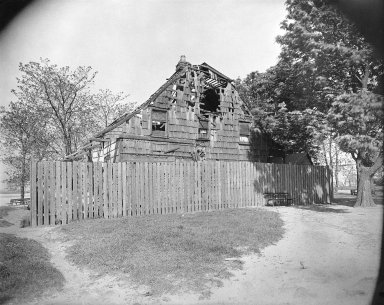
Nicholas Schenck. Nicholas Schenck House from Canarsie Park, ca. 1770–1775. Whole house Brooklyn Museum, Gift of the City of New York Parks and Recreation, 29.1283. Creative Commons-BY (Photo: Brooklyn Museum, 29.1283_canarsie_print_bw_SL1.jpg)
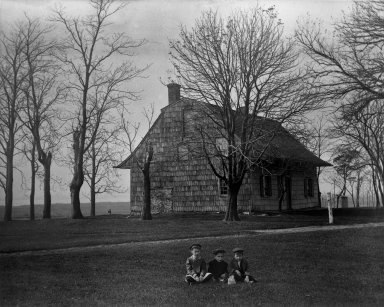
Nicholas Schenck. Nicholas Schenck House from Canarsie Park, ca. 1770–1775. Whole house Brooklyn Museum, Gift of the City of New York Parks and Recreation, 29.1283. Creative Commons-BY (Photo: Brooklyn Museum, 29.1283_house_exterior_in_situ_acetate_bw.jpg)

Nicholas Schenck. Nicholas Schenck House from Canarsie Park, ca. 1770–1775. Whole house Brooklyn Museum, Gift of the City of New York Parks and Recreation, 29.1283. Creative Commons-BY (Photo: Brooklyn Museum, 29.1283_house_print_bw_SL1.jpg)
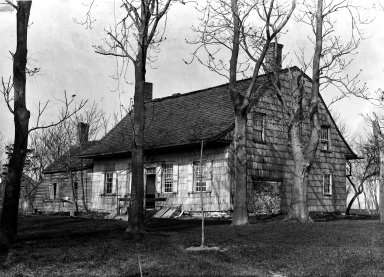
Nicholas Schenck. Nicholas Schenck House from Canarsie Park, ca. 1770–1775. Whole house Brooklyn Museum, Gift of the City of New York Parks and Recreation, 29.1283. Creative Commons-BY (Photo: Brooklyn Museum, 29.1283_in_situ_exterior_bw_IMLS.jpg)
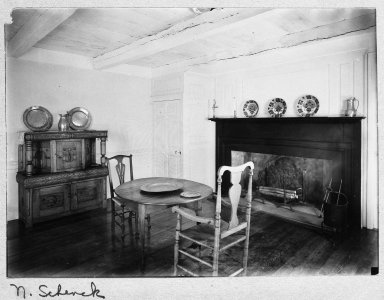
Nicholas Schenck. Nicholas Schenck House from Canarsie Park, ca. 1770–1775. Whole house Brooklyn Museum, Gift of the City of New York Parks and Recreation, 29.1283. Creative Commons-BY (Photo: Brooklyn Museum, 29.1283_undated_in_situ_interior_installation_preservation_record_negative_bw_IMLS.jpg)

Nicholas Schenck. Nicholas Schenck House from Canarsie Park, ca. 1770–1775. Whole house Brooklyn Museum, Gift of the City of New York Parks and Recreation, 29.1283. Creative Commons-BY (Photo: Brooklyn Museum, 29.1283_yr1928_hallway_north_in_situ_interior_installation_preservation_record_negative_bw_IMLS.jpg)
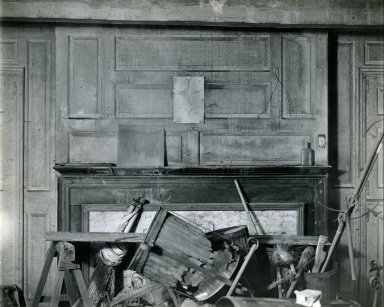
Nicholas Schenck. Nicholas Schenck House from Canarsie Park, ca. 1770–1775. Whole house Brooklyn Museum, Gift of the City of New York Parks and Recreation, 29.1283. Creative Commons-BY (Photo: Brooklyn Museum, 29.1283_neg17513_yr1928_in_situ_interior_southeast_room_print_bw_IMLS.jpg)
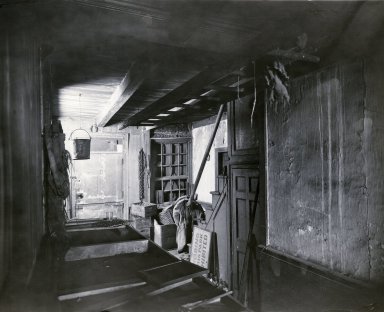
Nicholas Schenck. Nicholas Schenck House from Canarsie Park, ca. 1770–1775. Whole house Brooklyn Museum, Gift of the City of New York Parks and Recreation, 29.1283. Creative Commons-BY (Photo: Brooklyn Museum, 29.1283_neg17513_yr1928_in_situ_interior_stairs_print_bw_IMLS.jpg)

Nicholas Schenck. Nicholas Schenck House from Canarsie Park, ca. 1770–1775. Whole house Brooklyn Museum, Gift of the City of New York Parks and Recreation, 29.1283. Creative Commons-BY (Photo: Brooklyn Museum, 29.1283_yr1928_in_situ_interior_bedroom_print_bw_IMLS.jpg)

Nicholas Schenck. Nicholas Schenck House from Canarsie Park, ca. 1770–1775. Whole house Brooklyn Museum, Gift of the City of New York Parks and Recreation, 29.1283. Creative Commons-BY (Photo: Brooklyn Museum, 29.1283_yr1928_in_situ_interior_cellar_print_bw_IMLS.jpg)

Nicholas Schenck. Nicholas Schenck House from Canarsie Park, ca. 1770–1775. Whole house Brooklyn Museum, Gift of the City of New York Parks and Recreation, 29.1283. Creative Commons-BY (Photo: Brooklyn Museum, 29.1283_yr1928_in_situ_interior_northwest_room_print_bw_IMLS.jpg)
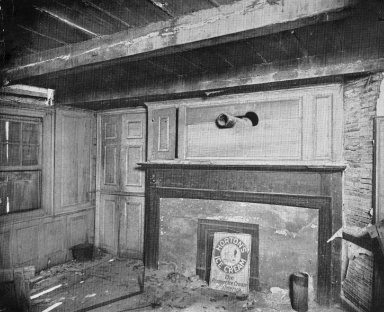
Nicholas Schenck. Nicholas Schenck House from Canarsie Park, ca. 1770–1775. Whole house Brooklyn Museum, Gift of the City of New York Parks and Recreation, 29.1283. Creative Commons-BY (Photo: Brooklyn Museum, 29.1283_yr1928_in_situ_interior_southwest_room_cropped_print_bw_IMLS.jpg)
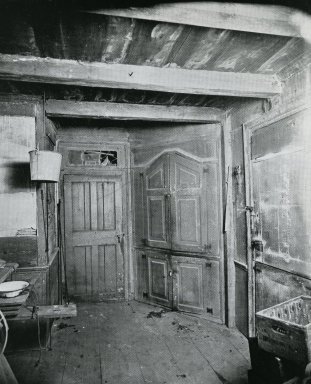
Nicholas Schenck. Nicholas Schenck House from Canarsie Park, ca. 1770–1775. Whole house Brooklyn Museum, Gift of the City of New York Parks and Recreation, 29.1283. Creative Commons-BY (Photo: Brooklyn Museum, 29.1283_yr1928_in_situ_north_hall_print_bw_IMLS.jpg)
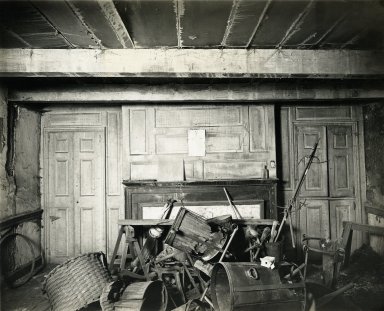
Nicholas Schenck. Nicholas Schenck House from Canarsie Park, ca. 1770–1775. Whole house Brooklyn Museum, Gift of the City of New York Parks and Recreation, 29.1283. Creative Commons-BY (Photo: Brooklyn Museum, 29.1283_yr1929_in_situ_interior_print_bw_IMLS.jpg)
Nicholas Schenck House from Canarsie Park
Decorative Arts and Design
On View: Decorative Art, Schenck Gallery, Parlor, 4th Floor
The Brooklyn Museum is commemorating its 200th anniversary by spotlighting 200 standout objects in its encyclopedic collection.
Like the Jan Martense Schenck house, the Nicholas Schenck house is a rare example of Dutch colonial architecture—and a symbol of the Schenck family’s power. Nicholas was the grandson of Jan Martense, whose 17th-century house was donated to the Brooklyn Museum in 1950. Nicholas’s home was built in present-day Canarsie around 1770–75. In 1929, New York Parks and Recreation donated the structure to the Museum to share a distinct account about the Schenck family and Dutch colonial homesteading in Brooklyn.
Nicholas was a wealthy merchant, and his economic comfort is evident in the steady architectural additions to his residence. While some of the dining room’s and parlor’s woodwork—painted in Prussian blue, an expensive color at the time—is original to the 18th-century construction, the building had expanded with two more bedrooms and a second floor by the 1820s.
From records, we know that two individuals were enslaved by Nicholas and labored as servants at his home. The homestead was built on land gifted to Nicholas from his grandfather. This type of settlement undeniably led to the erasure of Indigenous presence in Brooklyn, and specifically the Canarsie community through disease and targeted violence. For the Brooklyn Museum, the house is a key teaching tool to illustrate complicated historical narratives.
